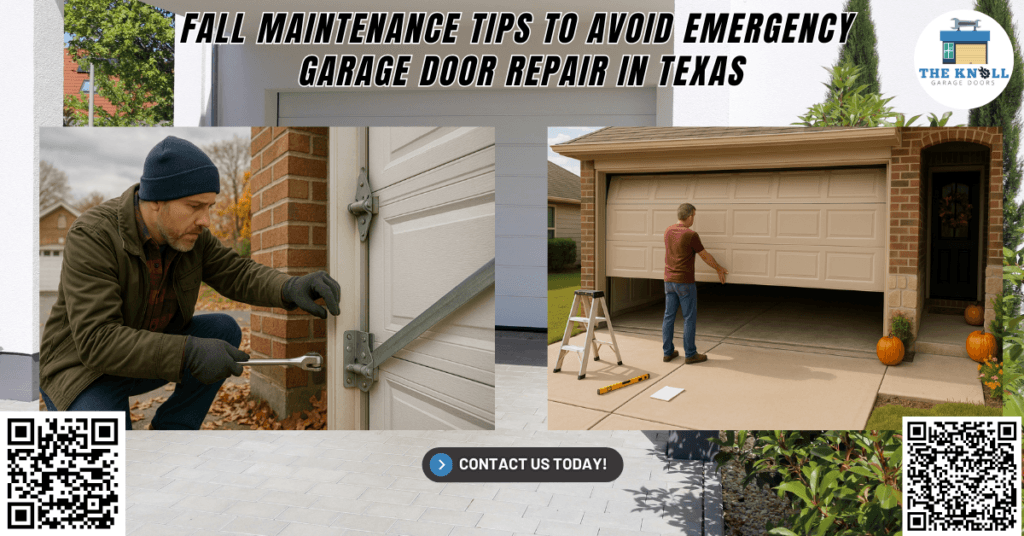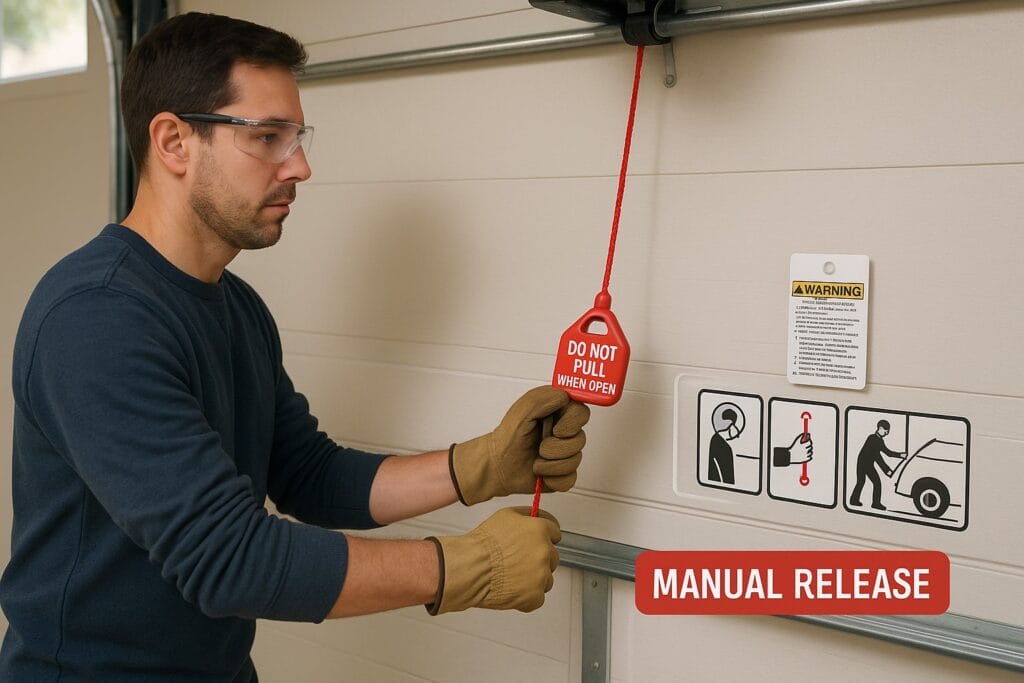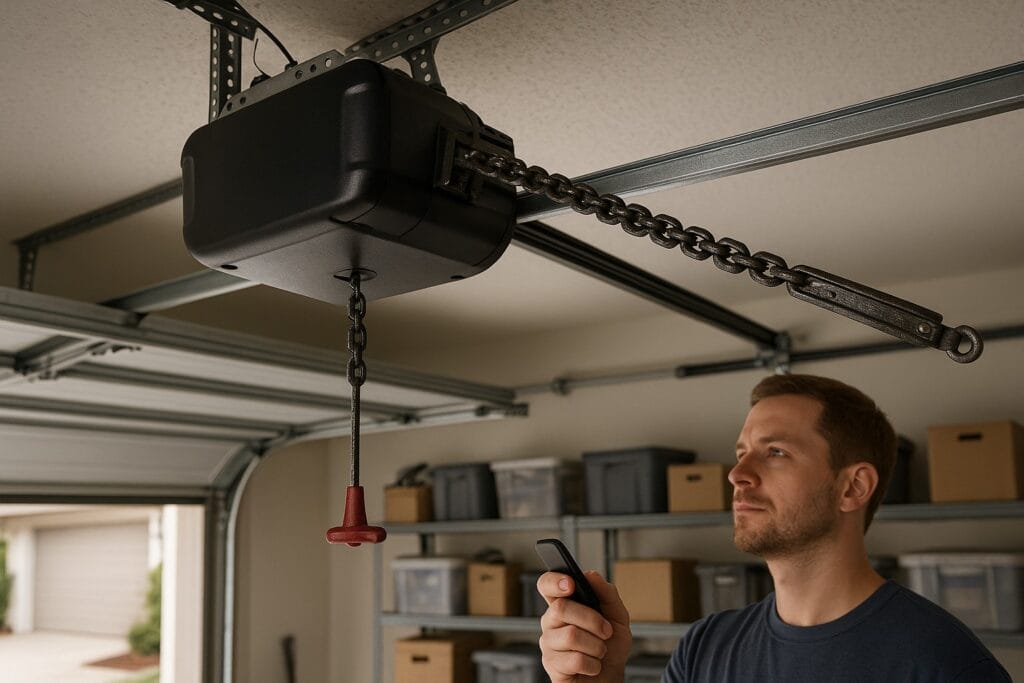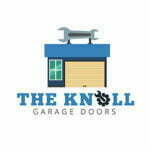Fall Maintenance Tips to Avoid Emergency Garage Door Repair in Texas

When the Thompsons from College Station gave us a frantic call one crisp October morning, their garage door had jammed midway, trapping their vehicle inside just before a family road trip. Upon inspection, we discovered a broken spring that had finally snapped after months of neglected maintenance. This unfortunate event led to a costly emergency garage door repair that could have easily been avoided with seasonal care.
Across the United States, garage doors are opened and closed approximately 1,500 times per year. With constant use, even the highest quality doors and openers will face wear and tear. Most emergency garage door repairs spike in the fall and winter due to sudden temperature drops that affect metal parts and components. Cold air causes metal to contract, placing added strain on springs, cables, and rollers, making regular maintenance more critical than ever.
For homeowners and businesses in Texas, fall is the perfect time to prepare your garage doors for seasonal changes. At The Knoll Garage Doors, our expert technicians specialize in helping clients across College Station and nearby areas avoid the stress and expense of emergency repairs. Here are the most effective fall maintenance tips to safeguard your garage door system and ensure year-round functionality and safety.
Why Fall Maintenance Is Crucial for Your Garage Door
As temperatures begin to dip in Texas, metal components such as garage door springs, tracks, and rollers start to contract. This thermal shift, while seemingly minor, can lead to significant performance issues. The combination of cooler weather, increased debris like leaves and dust, and early morning condensation can wreak havoc on even the most robust garage door systems.
Routine maintenance helps identify minor issues before they escalate into costly emergencies. Broken garage door springs or a malfunctioning opener can compromise not just your door’s function but also your home’s security. Moreover, proactive inspections in the fall reduce downtime and increase the longevity of your garage door system, whether it’s a residential unit or commercial garage doors.
Neglecting regular inspections can also cause damage to high-value components such as the c, garage door springs, and door panels. Once these parts fail, emergency repair becomes necessary, often at a higher cost and with longer wait times due to high seasonal demand. Taking a preventive approach through routine fall maintenance is not only a matter of safety but also a smart financial decision that protects your investment in your garage door system.
1. Inspect and Lubricate All Moving Parts
Every garage door system relies on numerous moving parts: springs, hinges, rollers, and bearings. Each of these components must move smoothly to maintain optimal performance. Without regular lubrication, friction builds up, leading to premature wear or even total failure. This can result in sudden breakdowns requiring emergency garage door repairs.
Using a high-quality silicone-based lubricant (not WD-40), homeowners can extend the life of these parts and reduce noise. Be sure to lubricate the torsion springs, roller shafts, and hinges thoroughly. Always wipe off any excess grease to prevent attracting dust and debris. Silicone sprays are particularly effective in Texas’s varying climate conditions, as they don’t degrade in cold or humid weather.
For example, one College Station homeowner contacted us after their garage door began making a grinding noise. Upon inspection, our technician found that dried-out rollers were putting stress on the opener. A simple lubrication job would have prevented the issue and avoided an emergency repair. We also advise checking the condition of your roller wheels—if they show signs of cracks or flat spots, they should be replaced immediately to ensure smooth door travel.
2. Check Garage Door Balance and Alignment
A misaligned or unbalanced garage door can strain your opener and create a safety hazard. Garage doors that are out of balance often drift down or shoot upward when manually lifted. This is typically a sign that the springs are wearing unevenly. Over time, uneven spring tension can cause warping in the door panels or premature opener failure, especially if left unresolved.
To check the balance, disconnect your garage door opener and lift the door halfway. If it stays in place, your balance is good. If it moves, your torsion springs may need adjustment. Do not attempt to adjust springs yourself; garage door spring repair should always be handled by trained technicians due to the high tension involved.

In one case, a business owner in the College Station area reported that their door wouldn’t stay open while unloading deliveries. We found that the springs had lost tension, causing a safety hazard for their employees. After a professional spring replacement and alignment, the issue was resolved, preventing future disruptions and ensuring compliance with workplace safety standards.
3. Clean the Tracks and Tighten Hardware
Garage door tracks guide the door as it opens and closes. Debris, dust, and cobwebs accumulate quickly, especially during the fall when windblown leaves and dirt make their way inside. Dirty or misaligned tracks can cause the door to operate unevenly or become stuck, increasing the chances of a breakdown or sudden jamming.
Use a damp cloth to clean both vertical and horizontal tracks thoroughly. Avoid using grease on the tracks, as this can attract grime. While cleaning, inspect for any dents or bends that may hinder movement. Use a level to ensure track alignment, as even slight misalignments can cause the rollers to jump off-track or bind.
Additionally, go over all the nuts, bolts, and brackets that hold the garage door system together. Vibrations from daily use loosen hardware over time, leading to rattling sounds or unstable movement. Tightening loose components is a simple yet vital part of garage door maintenance that helps avoid emergency repairs. Pay particular attention to the brackets that hold the tracks to the walls and ceiling, loose brackets can cause serious structural problems.
4. Test Auto-Reverse and Safety Sensor Features
Modern garage door openers come equipped with safety mechanisms like the auto-reverse system and photo-eye sensors. These features are designed to prevent accidents, especially if pets or children are in the path of a closing door. If these systems fail, your garage door becomes a serious safety hazard.
To test the auto-reverse, place a small block under the door and close it. The door should reverse immediately upon contact. For the photo-eye sensors, block the infrared beam while the door is closing; it should stop or reverse direction. If the door continues closing or hesitates before reversing, the sensors may be dirty or misaligned.
Homeowners should clean sensor lenses with a soft cloth and ensure both units are properly aligned. The sensors should blink when working correctly. If issues persist, our team at The Knoll Garage Doors can recalibrate or replace malfunctioning components. In many cases, we have prevented further damage or liability by identifying failed safety systems during seasonal tune-ups.
5. Replace Worn Weatherstripping and Seals
Weatherstripping plays a critical role in keeping your garage energy-efficient and protected from moisture, insects, and dust. Over time, rubber seals can crack, flatten, or become brittle, especially in the variable Texas climate. If left unchecked, these gaps allow outside elements to infiltrate your garage and affect your belongings and equipment stored inside.
Inspect the bottom seal of your garage door and the perimeter seals along the frame. If they appear damaged or aged, replace them promptly. This step also prevents water intrusion and reduces the chance of rodent infestation. Modern garage door seals are made from high-durability rubber compounds designed to withstand seasonal changes and heavy use.
Our team recently serviced a local business whose garage door had no effective weather seal. Rain had seeped in and caused rust on the lower panel tracks. This led to a full emergency garage door replacement, which could have been avoided with a simple fall inspection. We recommend checking seals twice a year and replacing them as soon as cracks or flattening appear.
6. Evaluate the Garage Door Opener
The garage door opener is the heart of the system. If it fails, your entire garage door could become inoperable. Fall is an ideal time to test its responsiveness, check backup batteries, and ensure the chain or belt drive is in good condition. Many modern garage door openers come equipped with Wi-Fi connectivity, enabling smartphone control, which should also be tested.
Listen for strange noises or lag when operating the door. These can be signs of motor strain or worn gears. Additionally, test the wall controls and remote openers. If there’s any delay, consider replacing the batteries or checking the wiring. Be sure to inspect the emergency release cord to ensure it operates smoothly.

Openers from reputable brands like LiftMaster, Genie, and Chamberlain often include built-in diagnostics. Still, if you’re unsure, our technicians can run full diagnostics to ensure your opener doesn’t leave you stuck on a cold morning. If your opener is more than 10 years old, it might be time to consider a replacement with improved safety features and energy-efficient performance.
7. Watch for Pest and Rodent Activity
As temperatures drop, pests seek warmth and shelter. Your garage, especially one with worn seals or gaps, can become a haven for rodents, spiders, and insects. These intruders can chew through wires, nest inside control boxes, or damage insulation. Once inside, they can create health hazards and disrupt electrical components essential to your garage door’s function.
Inspect corners, around sensors, and near the door’s base for signs of gnawing or droppings. Seal off entry points with steel wool or weatherproof caulk. Installing a rodent-proof bottom seal can make a significant difference. Consider adding ultrasonic pest deterrents or traps in the garage during cooler months.
Rodent damage can cause garage door malfunctions that may not be visible until a complete breakdown occurs. In such cases, emergency garage door repairs become the only solution. Preventive pest control is just as important as mechanical maintenance when it comes to garage door longevity.
8. Schedule a Professional Inspection
While many fall maintenance tasks can be DIY-friendly, having a professional perform a full tune-up offers unmatched peace of mind. At The Knoll Garage Doors, our expert technicians provide comprehensive maintenance packages that include:
- Spring tension testing
- Opener diagnostics
- Roller and cable inspection
- Track and alignment adjustment
- Sensor recalibration
- Weather seal replacement
Our services are designed to detect hidden problems and offer proactive solutions before they become emergencies. With over 15 years of experience, our team knows exactly what Texas homeowners and businesses need to keep their garage doors functioning year-round. We work with all major brands, including Door-Mart™ Garage Doors, ProLift Garage Doors, and Xperts Garage Door systems.
An annual professional inspection is especially crucial for commercial properties that rely on overhead doors for daily operations. Our team ensures all safety protocols are met and that your door system is optimized for both performance and compliance.
Final Thoughts: Stay Ahead of Garage Door Emergencies
Seasonal maintenance isn’t just about avoiding the hassle of a stuck garage door—it’s about ensuring the safety, security, and convenience of your home or business. Every component, from springs and rollers to openers and seals, plays a role in seamless operation. Fall is the perfect season to give your system the attention it deserves.
Ignoring early warning signs can lead to inconvenient and expensive emergency garage door repairs. But with regular inspections, timely lubrication, and professional tune-ups, you can enjoy uninterrupted access and greater peace of mind.
As a homeowner or property manager in the College Station area, you deserve service that prioritizes your needs, your schedule, and your safety. Whether you’re dealing with broken springs, worn-out parts, or preparing your door for winter, trust the local experts. With proper fall garage door maintenance, you can keep your garage door operating smoothly for years and avoid unnecessary emergencies.
How Can The Knoll Garage Doors Help You?
At The Knoll Garage Doors, we pride ourselves on delivering reliable, affordable, and top-quality garage door services tailored to your needs. Located at 2322 Texas Ave S, College Station, TX 77840, we provide same-day garage door repairs, emergency garage door repairs, and full installations for residential and commercial properties alike.
Our experienced team of technicians is trained to handle everything from broken springs and malfunctioning garage door openers to full garage door replacements. Whether you need routine maintenance or urgent emergency repair, we offer dependable solutions backed by warranties and years of industry knowledge.
Call us today at (979) 978-0221 to schedule your fall maintenance inspection or to get emergency garage door repair help when you need it most. Our expert technicians are standing by to offer safe, efficient, and lasting solutions for any garage door issues you face.
Let The Knoll Garage Doors be your first call for professional service, proven solutions, and guaranteed customer satisfaction.
Frequently Asked Questions (FAQs)
1. How long do garage door springs typically last?
Torsion springs usually last between 10,000 to 15,000 cycles, which equates to 7–12 years of average use depending on how often the door is opened.
2. Can I replace a garage door opener battery myself?
Yes, most garage door opener batteries are user-replaceable and are located in the wall control panel or the remote unit; just be sure to use the correct battery type.
3. What are the signs of a failing garage door opener?
Common signs include the door moving more slowly than usual, making grinding noises, failing to open or close consistently, or the remote not responding.
4. Does homeowner’s insurance cover emergency garage door repairs?
Coverage depends on the cause; accidental damage or certain weather-related issues may be covered, but wear and tear or lack of maintenance typically are not.
